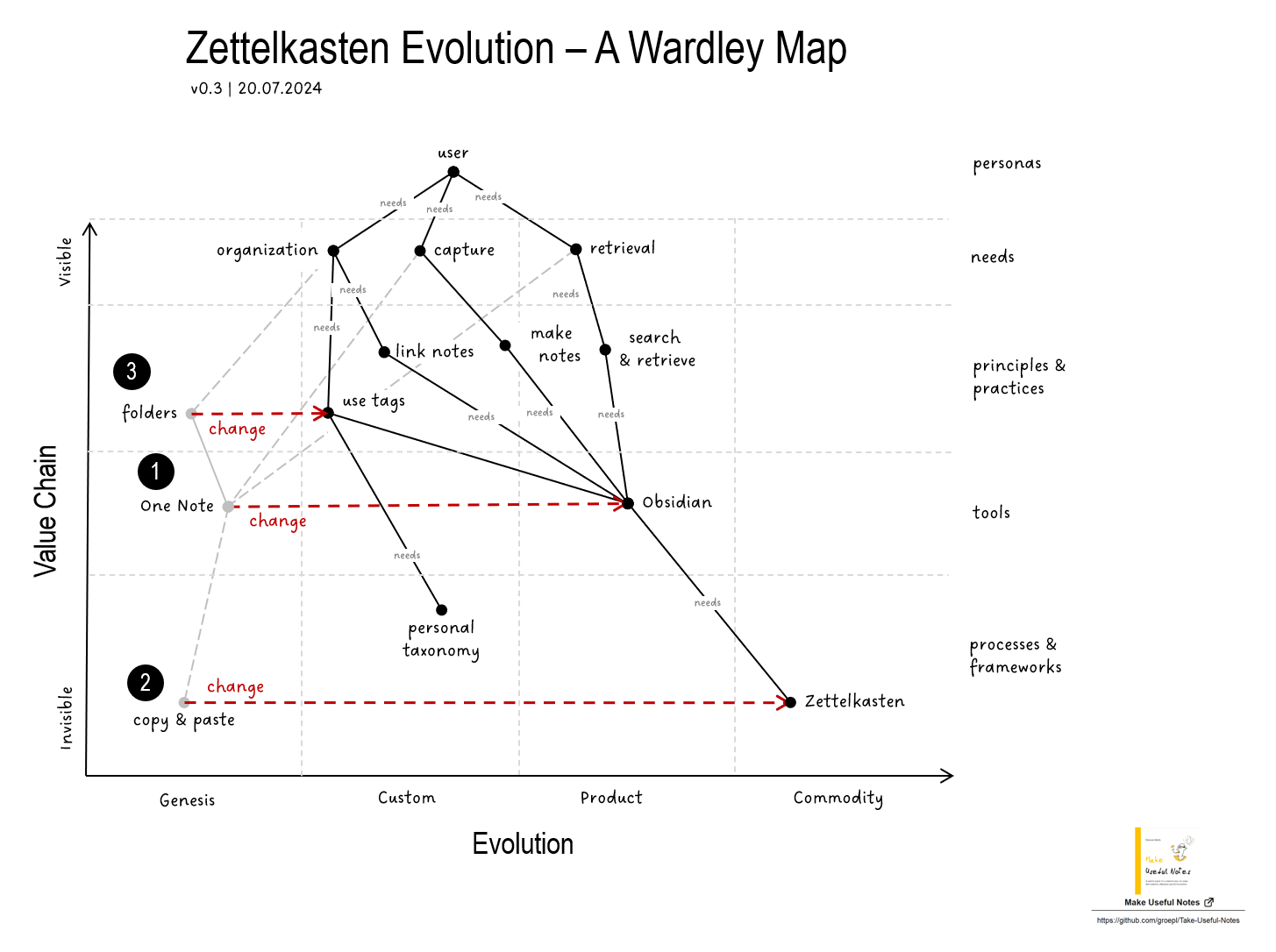Zettelkasten Evolution - A Wardley Map
Working with my Zettelkasten constantly evolves, as my needs change over time. It seems to be an endless journey to improve my personal knowledge management system. By chance, I discovered "Wardley Mapping" by Simon Wardley [1]. It's a method for understanding how to develop your strategies. My first idea to learn more about this visual tool was to apply it to my Zettelkasten strategy.
Let's take a closer look. A Wardley map allows us to visualize the **Evolution **of business components over time. It starts from the unstable beginnings to more stable, standardized components. These components fall into four stages: genesis, custom, product, and commodity.
First: Genesis components are novel and new. Second: Custom components exist for a specific use case with some proof of value. Third: Product components are standardized and reliable elements. And last: Commodity components are best practices, well defined, and widely used.

In the Value Chain, the underlying methods and practices are implemented at various stages to enhance the overall effectiveness and efficiency of the system.
Developing a Wardley Map for using a Zettelkasten in my personal knowledge management involves outlining several components to understand and strategize my approach effectively:
- Purpose: Efficiently manage and leverage personal knowledge for continuous learning and productivity.
- Scope: Digital note-taking, linking ideas, research support, excluding team collaboration.
- User: Primarily self.
- User Needs: Quick note capture, efficient organization with tagging and linking, easy retrieval.
- Value Chain: From user to Zettelkasten.
- Wardley Map: Helps to visualize the different components and their current state in the evolution, guiding where to focus efforts to improve my personal knowledge management system.
Here is my story: (1) I started my changes to improve my personal knowledge management system by moving from OneNote to Obsidian two years ago. (2) The biggest change was my first contact with the Zettelkasten framework. (3) Here it was really tough for me to change my personal organization from thinking in "folders" to "tagging".
Now my current challenge is to use analytical reading [2] to improve my notes. And I'm sure I'll need another Wardley map. As it is said by Simon Wardley: "There’s nothing wrong with you. Developing a strategy is just hard.".
What will the next steps be? What are your recommendations?
References
[1] Wardley, Simon. “Wardley Maps.” Learn Wardley Mapping. Accessed July 17, 2024. https://learnwardleymapping.com/book/.
[2] Adler, Mortimer Jerome, and Charles Lincoln Van Doren. How to Read a Book. Touchstone edition. New York, Touchstone, 2014.
. . .
Text and visual updated based on helpful critique from @Andy
Edmund Gröpl
100% organic thinking. Less than 5% AI-generated ideas.
Howdy, Stranger!

Comments
@Edmund, thanks for introducing me to Wardley's framework. My initial response is that the graphic is too opaque/obscure. For me, the graphic is much more difficult to read and understand than the mind maps and other diagrams that you usually post.
The paragraph you wrote that begins "And here is my story..." is perfectly clear. If you wrote that paragraph after using Wardley's framework to gain new insights that you then described in prose, then perhaps Wardley's framework was useful to you as a thinking tool even if the graphic is mostly unhelpful for communicating those insights to other people. If you already knew that story before using Wardley's framework, then I wonder what new insights you gained from the framework that you didn't already know?
The categories on the horizontal "evolution" axis don't seem very relevant to the story that you're telling.
@Andy , Thank you for your feedback with many personal insights.
For me, the Wardley Map is a tool to keep the visual and textual statements and contexts consistent. If this is not the case, I have to adjust the text or the graphics. The two go hand in hand. Gives me some time to prepare an update.
Edmund Gröpl
100% organic thinking. Less than 5% AI-generated ideas.
Can you see the parallel concepts? The Value Chain in the Wardley Map connects elements from visible to invisible, the Iceberg Model uses the oposite direction. More: https://forum.zettelkasten.de/discussion/comment/20245#Comment_20245
Edmund Gröpl
100% organic thinking. Less than 5% AI-generated ideas.